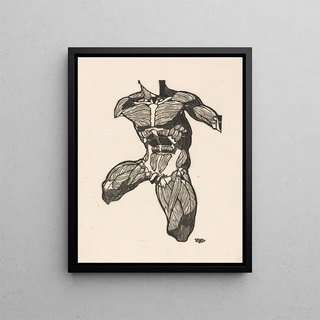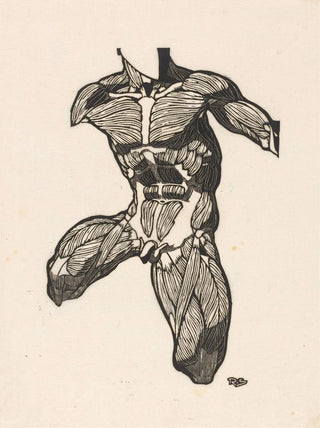Art print | Anatomical study of the muscles of the neck, abdomen, and thighs of a man - Reijer Stolk


View from behind

Frame (optional)
Reproduction Anatomical study of the muscles of the neck, abdomen, and thighs of a man - Reijer Stolk – Captivating introduction
The artwork "Anatomical study of the muscles of the neck, abdomen, and thighs of a man" by Reijer Stolk presents itself as a true exploration of the human body, revealing the complexity and beauty of muscular structure. In a world where art and science intersect, this study is part of a tradition where meticulous observation and realism combine to create a work that is both aesthetic and educational. By delving into this representation, the viewer is invited to appreciate not only the artist's technique but also the richness of anatomical knowledge of its time. This piece, which transcends simple drawing, becomes an open window into the scientific and artistic concerns of the 17th century.
Style and uniqueness of the work
Stolk's style is distinguished by remarkable precision and attention to detail that demonstrate exceptional mastery. Every muscle, every tendon is rendered with clarity that allows understanding of the movements and functions of the human body. The artist uses delicate lines and subtly nuanced shadows to bring his subjects to life, transforming a simple anatomical study into a captivating art print. This realism, almost photographic, is accompanied by an almost poetic approach to anatomy, where art and science are one. The choice of poses, the arrangement of muscles, everything is designed to evoke a dynamic that goes beyond mere static representation. Thus, Stolk manages to create an emotional connection with the viewer, inviting them to contemplate the beauty of the human body from a new perspective.
The artist and his influence
Reijer Stolk, a Dutch artist of the 17th century, is often considered a pioneer in the field of artistic anatomy. His work is set in a context where the study of the human body was booming, driven by advances in medicine and biology. Stolk skillfully leveraged these discoveries to enrich his art, influencing many contemporaries and future artists. His innovative approach helped redefine how anatomy was perceived and represented in

Matte finish

View from behind

Frame (optional)
Reproduction Anatomical study of the muscles of the neck, abdomen, and thighs of a man - Reijer Stolk – Captivating introduction
The artwork "Anatomical study of the muscles of the neck, abdomen, and thighs of a man" by Reijer Stolk presents itself as a true exploration of the human body, revealing the complexity and beauty of muscular structure. In a world where art and science intersect, this study is part of a tradition where meticulous observation and realism combine to create a work that is both aesthetic and educational. By delving into this representation, the viewer is invited to appreciate not only the artist's technique but also the richness of anatomical knowledge of its time. This piece, which transcends simple drawing, becomes an open window into the scientific and artistic concerns of the 17th century.
Style and uniqueness of the work
Stolk's style is distinguished by remarkable precision and attention to detail that demonstrate exceptional mastery. Every muscle, every tendon is rendered with clarity that allows understanding of the movements and functions of the human body. The artist uses delicate lines and subtly nuanced shadows to bring his subjects to life, transforming a simple anatomical study into a captivating art print. This realism, almost photographic, is accompanied by an almost poetic approach to anatomy, where art and science are one. The choice of poses, the arrangement of muscles, everything is designed to evoke a dynamic that goes beyond mere static representation. Thus, Stolk manages to create an emotional connection with the viewer, inviting them to contemplate the beauty of the human body from a new perspective.
The artist and his influence
Reijer Stolk, a Dutch artist of the 17th century, is often considered a pioneer in the field of artistic anatomy. His work is set in a context where the study of the human body was booming, driven by advances in medicine and biology. Stolk skillfully leveraged these discoveries to enrich his art, influencing many contemporaries and future artists. His innovative approach helped redefine how anatomy was perceived and represented in






